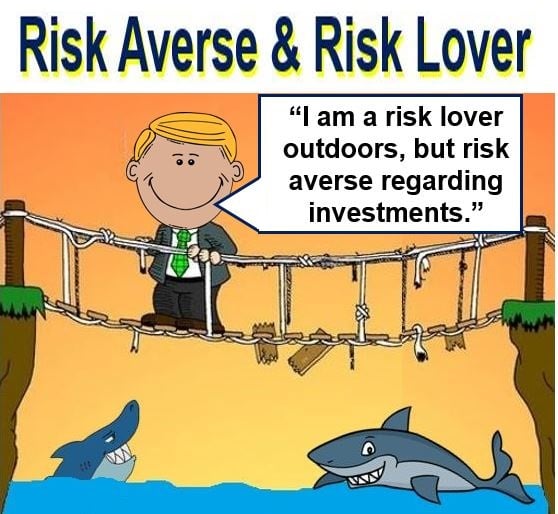Risk-Averse investors do not like taking risks. They prefer lower returns instead of higher ones because the lower return investments are less risky. The higher return ones, on the other hand, have unknown or potentially higher risks.
We also use the term outside the world of business and finance. Look at this phrase: “She believes that attitudes today to children’s play are too restrictive and risk-averse.” In other words, she thinks adults are over-protecting children.
When you present risk-averse investors with several investments giving the same return but with different levels of risk, they will always opt for the safest ones. Risk-seeking investors, on the other hand, will do the opposite. Risk-seeking people like risk.
Risk-averse investors also tend to favor liquidity in their investments, ensuring that they can access their funds without significant losses if circumstances change.

Risk-averse investor avoids risk
Put simply, risk-averse investors avoid risk and stay away from more speculative investments. Such investors like index funds, government bonds, and debentures. In fact, even with bonds, those who do not like risk probably favor laddering.
Laddering means purchasing several bonds with different maturity dates. It is a strategy that reduces risk and helps maintain a regular income.
Risk-averse consumers are less likely to accept a bargain if the payoff or benefit is uncertain. They will also tend to choose the same product at the normal list price if the payoff is certain.
Risk-averse individuals tend to prioritize the preservation of capital over the potential for high returns, often opting for investments like savings accounts or certificates of deposit.

According to Macmillan Dictionary, a risk-averse person is:
“Opposed to taking risks, or only willing to take small risks.”
Risk-averse vs. risk seeker
Imagine you offered two people either a certain payment of $50 or the chance to receive $100. However, the $100 option also carries the risk of receiving nothing. How would a risk-seeker and risk-averse person react?
A risk-averse individual would choose the certain payment of $50.
A risk seeker, however, would probably opt for the riskier $100 or nothing choice.
The expected value – the average payoff of the gamble – is $50. The amount that the risk-averse individual would accept rather than gambling is known as the certainty equivalent. The difference between the expected value and certainty equivalent is the risk premium.
For people with risk aversion, the risk premium becomes positive. For risk-loving investors, however, it becomes negative, while for risk-neutral people it is zero.
Risk neutral investors are people who are totally insensitive to risk. This type of investor is extremely rare.
Human attitudes to risk
Our attitudes to risk vary depending on the situation. Mary, for example, may take great risks in sporting events. However, she might be risk-averse when deciding where to invest her savings.
Our risk behaviors also appear to change as we get older, wealthier, and start having children.
According to economists, we make choices to maximize expected utility rather than wealth.
According to Diffusion of Innovations theory, innovators are the least risk-averse adopters of new products or technologies. Laggards, on the other hand, are highly skeptical of anything new, i.e., their risk aversion is high.
Brief history
The term “risk-averse” first appeared in the English language in the early 20th century.
The concept of risk aversion became widely talked and written about following the work of economists like John von Neumann (1903-1957) and Oskar Morgenstern (1902-1977) in the 1940s. They developed Expected Utility Hypothesis, which mathematically formalized the behavior of risk-averse individuals.
From the mid-20th century onwards, both terms – “risk-averse” and risk-seeking – became more widely used in academic literature and economic textbooks.
